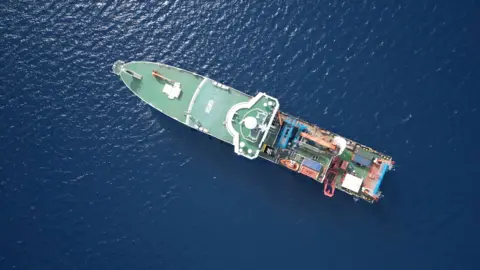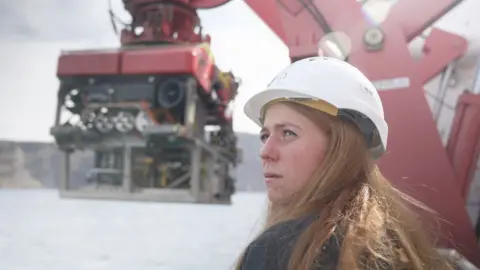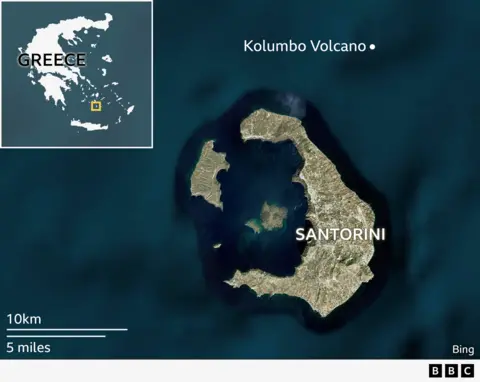begin quote from:
https://www.bbc.com/news/articles/cm25lz56rezo
Could an almighty eruption destroy a dreamy Greek island?
 Kevin Church/BBC
Kevin Church/BBCPerched on top of Santorini's sheer cliffs is a world-famous tourist industry worth millions. Underneath is the fizzing risk of an almighty explosion.
A huge ancient eruption created the dreamy Greek island, leaving a vast crater and a horse-shoe shaped rim.
Now scientists are investigating for the first time how dangerous the next big one could be.
BBC News spent a day on board the British royal research ship the Discovery as they searched for clues.
 Kevin Church/BBC
Kevin Church/BBCJust weeks before, nearly half of Santorini's 11,000 residents had fled for safety when the island shut down in a series of earthquakes.
It was a harsh reminder that under the idyllic white villages dotted with gyros restaurants, hot tubs in AirBnB rentals, and vineyards on rich volcanic soil, two tectonic plates grind in the Earth's crust.
Prof Isobel Yeo, an expert on highly dangerous submarine volcanoes with Britain's National Oceanography Centre, is leading the mission. Around two-thirds of the world's volcanoes are underwater, but they are hardly monitored.
"It's a bit like 'out of sight, out of mind' in terms of understanding their danger, compared to more famous ones like Vesuvius," she says on deck, as we watch two engineers winching a robot the size of a car off the ship's side.
This work, coming so soon after the earthquakes, will help scientists understand what type of seismic unrest could indicate a volcanic eruption is imminent.
Santorini's last eruption was in 1950, but as recently as 2012 there was a "period of unrest", says Isobel. Magma flowed into the volcanoes' chambers and the islands "swelled up".
 Kevin Church/BBC
Kevin Church/BBC"Underwater volcanoes are capable of really big, really destructive eruptions," she says.
"We are lulled into a sense of false security if you're used to small eruptions and the volcano acting safe. You assume the next will be the same - but it might not," she says.
The Hunga Tunga eruption in 2022 in the Pacific produced the largest underwater explosion ever recorded, and created a tsunami in the Atlantic with shockwaves felt in the UK. Some islands in Tonga, near the volcano, were so devastated that their people have never returned.
Beneath our feet on the ship, 300m (984ft) down, are bubbling hot vents. These cracks in the Earth turn the seafloor into a bright orange world of protruding rocks and gas clouds.
"We know more about the surface of some planets than what's down there," Isobel says.
The robot descends to the seabed to collect fluids, gases and snap off chunks of rock.
Those vents are hydrothermal, meaning hot water pours out from cracks, and they often form near volcanoes.
They are why Isobel and 22 scientists from around the world are on this ship for a month.
So far, no-one has been able to work out if a volcano becomes more or less explosive when sea water in these vents mixes with magma.
"We are trying to map the hydrothermal system," Isobel explains. It's not like making a map on land. "We have to look inside the earth," she says.

No comments:
Post a Comment